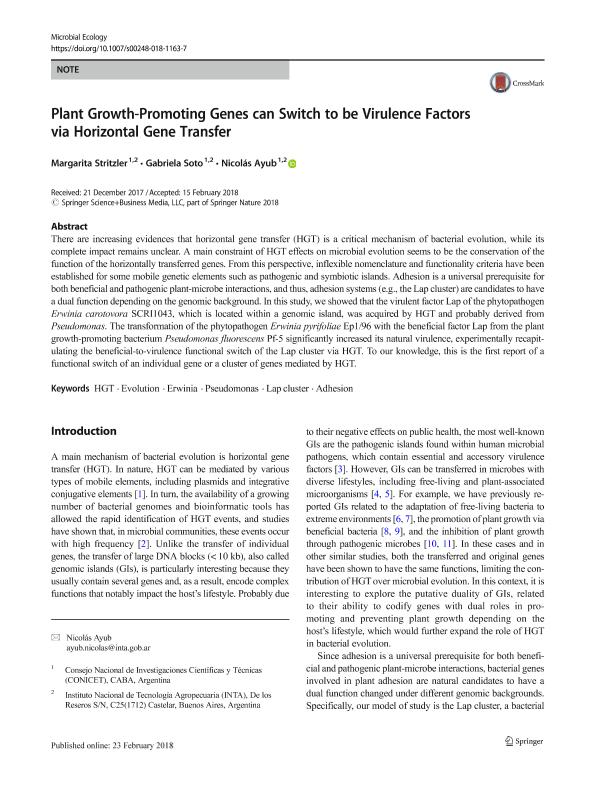Artículo
Plant Growth-Promoting Genes can Switch to be Virulence Factors via Horizontal Gene Transfer
Fecha de publicación:
10/2018
Editorial:
Springer
Revista:
Microbial Ecology
ISSN:
0095-3628
Idioma:
Inglés
Tipo de recurso:
Artículo publicado
Clasificación temática:
Resumen
There are increasing evidences that horizontal gene transfer (HGT) is a critical mechanism of bacterial evolution, while its complete impact remains unclear. A main constraint of HGT effects on microbial evolution seems to be the conservation of the function of the horizontally transferred genes. From this perspective, inflexible nomenclature and functionality criteria have been established for some mobile genetic elements such as pathogenic and symbiotic islands. Adhesion is a universal prerequisite for both beneficial and pathogenic plant-microbe interactions, and thus, adhesion systems (e.g., the Lap cluster) are candidates to have a dual function depending on the genomic background. In this study, we showed that the virulent factor Lap of the phytopathogen Erwinia carotovora SCRI1043, which is located within a genomic island, was acquired by HGT and probably derived from Pseudomonas. The transformation of the phytopathogen Erwinia pyrifoliae Ep1/96 with the beneficial factor Lap from the plant growth-promoting bacterium Pseudomonas fluorescens Pf-5 significantly increased its natural virulence, experimentally recapitulating the beneficial-to-virulence functional switch of the Lap cluster via HGT. To our knowledge, this is the first report of a functional switch of an individual gene or a cluster of genes mediated by HGT.
Palabras clave:
ADHESION
,
ERWINIA
,
EVOLUTION
,
HGT
,
LAP CLUSTER
,
PSEUDOMONAS
Archivos asociados
Licencia
Identificadores
Colecciones
Articulos(SEDE CENTRAL)
Articulos de SEDE CENTRAL
Articulos de SEDE CENTRAL
Citación
Stritzler, Margarita; Soto, Gabriela Cynthia; Ayub, Nicolás Daniel; Plant Growth-Promoting Genes can Switch to be Virulence Factors via Horizontal Gene Transfer; Springer; Microbial Ecology; 76; 3; 10-2018; 579-583
Compartir
Altmétricas




